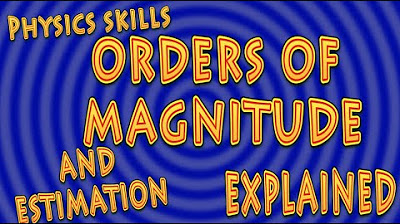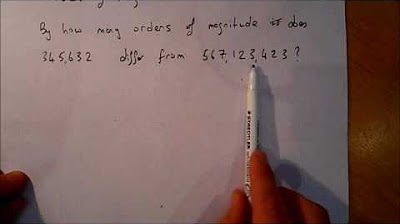Orders of Magnitude
TLDRThe video script introduces the concept of orders of magnitude, a method for approximating and comparing the scale of different quantities. It uses the analogy of Lego blocks to explain how to calculate orders of magnitude, emphasizing the importance of identifying the system and quantity being examined. The script further illustrates this concept with examples of different objects, such as wooden, aluminum, and tungsten cubes, and their respective masses, highlighting how orders of magnitude can reveal significant differences in quantities that are not immediately apparent. The video encourages viewers to practice calculating orders of magnitude to better understand and compare large or small values in various contexts.
Takeaways
- 📈 Orders of magnitude are used to compare very large or very small quantities.
- 🔢 It involves finding the approximate logarithm to a reference value, usually 10.
- 🧱 The video uses lego bricks to illustrate how to calculate orders of magnitude for different quantities.
- 📏 The first step is to define the system and the quantity you are examining.
- 🔄 When quantities increase by a factor of 10, it represents an increase of one order of magnitude.
- 📊 Even with the same volume, different materials can have significantly different masses and orders of magnitude.
- 🌳 The concept can be applied to compare various aspects of ecosystems, like biodiversity or surface area.
- 🌐 Examples include comparing the vast Amazon rainforest to a small pond like Devil's Hole in Nevada.
- 🔎 Orders of magnitude allow for quick comparisons and approximations of large or small values.
- 💡 Understanding orders of magnitude helps in grasping the scale and significance of different quantities.
- 📝 Practice is essential to get comfortable with calculating and using orders of magnitude.
Q & A
What is the main concept discussed in the video?
-The main concept discussed in the video is 'orders of magnitude,' which is a method for approximating and comparing the size of quantities, particularly when dealing with very large or very small numbers.
How does the video introduce the idea of orders of magnitude?
-The video introduces the idea of orders of magnitude by using the example of counting LEGO bricks. It explains that an order of magnitude is an approximation of the logarithm to a reference value, usually 10.
What is the significance of the number 10 in orders of magnitude?
-The number 10 is significant in orders of magnitude because it serves as the reference value for approximation. Each order of magnitude represents a power of 10, such as 10, 100, 1000, and so on.
How does the video demonstrate the calculation of orders of magnitude for different quantities?
-The video demonstrates the calculation of orders of magnitude by using the quantities of LEGO bricks as examples. It shows how to identify the system, write down the quantity, and then determine the order of magnitude based on how close the number is to a power of 10.
What is the purpose of using orders of magnitude in calculations?
-The purpose of using orders of magnitude is to quickly compare and approximate large or small values. It provides a way to understand the scale of quantities without having to deal with exact numbers, making it easier to grasp the magnitude of differences between them.
How does the video use cubes of different materials to illustrate orders of magnitude?
-The video uses cubes made of wood, aluminum, and tungsten to illustrate orders of magnitude. Despite having the same volume, the cubes have significantly different masses, which are then used to calculate their orders of magnitude, highlighting the difference in mass even when volume is constant.
What are the three different orders of magnitude calculated for the cubes in the video?
-The wooden cube, weighing 32 grams, has an order of magnitude of 1. The aluminum cube, weighing 149 grams, has an order of magnitude of 2. The tungsten cube, weighing 999 grams (essentially a kilogram), has an order of magnitude of 3.
How does the video suggest using orders of magnitude to compare different ecosystems?
-The video suggests using orders of magnitude to compare different ecosystems by looking at factors such as surface area or biodiversity. It provides the example of comparing the vast Amazon rainforest ecosystem with the much smaller Devil's Hole pond ecosystem in Nevada.
What is the practical application of understanding orders of magnitude?
-Understanding orders of magnitude is practical because it allows for quick and easy comparison of very large or very small quantities. This can be particularly useful in scientific calculations, data analysis, and making sense of complex or vast data sets.
How does the video emphasize the importance of measurement in understanding orders of magnitude?
-The video emphasizes the importance of measurement by showing that even though the cubes have the same volume, their masses differ significantly. This difference is only revealed through actual measurement and calculation of orders of magnitude, highlighting that appearances can be deceiving and precise measurements are necessary for accurate comparisons.
What is the final exercise the video suggests for the viewer?
-The final exercise the video suggests is for the viewer to calculate the orders of magnitude for a set of provided values, which include both surface area and biodiversity of ecosystems like the Amazon rainforest and Devil's Hole pond. This exercise is meant to help the viewer practice and solidify their understanding of the concept.
Outlines
📏 Introduction to Orders of Magnitude
This paragraph introduces the concept of orders of magnitude, emphasizing the importance of understanding the scale and size of quantities. It explains that orders of magnitude are a way to approximate the logarithm to a reference value, typically 10. The explanation begins with a simple example of counting LEGO bricks, illustrating how to define the system, identify the quantity, and calculate the order of magnitude. The paragraph highlights the significance of orders of magnitude in comparing large or small numbers quickly and efficiently.
📏 Comparing Mass with Orders of Magnitude
This paragraph delves into applying the concept of orders of magnitude to compare the mass of different objects, using the example of three cubes made of wood, aluminum, and tungsten. It demonstrates how despite having the same volume, the mass of these cubes can vary significantly, leading to different orders of magnitude. The paragraph encourages viewers to pause and calculate the orders of magnitude for the given quantities, reinforcing the idea that orders of magnitude are a useful tool for approximating and comparing values, even when the exact numbers are not round figures.
🌿 Orders of Magnitude in Ecosystems
The final paragraph of the script discusses the application of orders of magnitude in the context of ecosystems, contrasting the vast Amazon rainforest with the small Devil's Hole pond in Nevada. It suggests that understanding orders of magnitude can provide insights into the scale and complexity of different ecosystems. The paragraph concludes by encouraging practice and exploration of orders of magnitude to gain a deeper understanding of quantities and their relative sizes in various contexts.
Mindmap
Keywords
💡Orders of Magnitude
💡Legos
💡Mass
💡Volume
💡Density
💡Ecosystem
💡Biodiversity
💡Surface Area
💡Logarithm
💡Reference Value
💡Approximation
Highlights
The video introduces the concept of orders of magnitude, a method to compare and approximate large or small quantities.
Orders of magnitude are calculated by identifying the system and quantity being examined, such as the number of Lego bricks in different bundles.
An order of magnitude is an approximation of the logarithm to a reference value, typically 10.
The video demonstrates how to calculate orders of magnitude using Lego bricks, showing that 10 Lego bricks represent an order of magnitude of one, and 100 Lego bricks represent two.
When comparing quantities, a difference of one order of magnitude indicates a tenfold difference in quantity.
The video also explores the concept with different objects, such as comparing the mass of wooden, aluminum, and tungsten cubes with the same volume.
Despite having the same volume, the cubes can have significantly different orders of magnitude based on their mass.
The wooden cube, weighing 32 grams, has a different order of magnitude compared to the tungsten cube, which weighs nearly a thousand grams.
The concept of orders of magnitude can be applied to various fields, such as comparing different ecosystems like the Amazon rainforest and Devil's Hole in Nevada.
The video encourages viewers to practice calculating orders of magnitude using provided data on surface area and biodiversity of ecosystems.
The method of orders of magnitude is a quick way to compare large or small values and provides a sense of the scale of quantities.
The video emphasizes the importance of understanding orders of magnitude for grasping the true scale of differences in quantities.
Orders of magnitude can be used to compare values across various units, making it a versatile tool for scientific and everyday comparisons.
The video provides a practical example of how orders of magnitude can reveal hidden differences, such as the mass of cubes with the same volume.
The concept of orders of magnitude helps in understanding complex data and making sense of the scale of quantities in various contexts.
Transcripts
5.0 / 5 (0 votes)
Thanks for rating:





